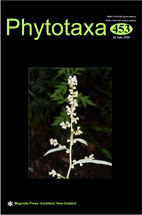Abstract
A new orchid species, Cymbidium codonanthum, from Yunnan Province, China, is described and illustrated based on morphological and molecular analyses. A detailed comparison between the newly discovered orchid and other members of Cymbidium was performed. The new plant what is similar to C. cochleare, but it is characterized by several morphological features that distinguish it from the latter as well as all other known species of Cymbidium. A molecular study based on nuclear ribosomal ITS and plastid matK and rbcL DNA sequence data indicates that C. codonanthum is genetically distinct from other species and a member of Cymbidium section Cyperochis.
References
Chen, S.C., Liu, Z.J., Zhu, G.H., Lang, K.Y., Ji, Z.H., Luo, Y.B., Jin, X.H., Cribb, P.J., Wood, J.J., Gale, S.W., Ormerod, P., Vermeulen, J.J., Wood, H.P., Clayton, D. & Bell, A. (2009) Orchidaceae. In: Wu, Z.Y., Raven, P.H. & Hong, D. (Eds.) Flora of China, vol. 25. Science Press, Beijing & Missouri Botanical Garden Press. St. Louis, pp. 211–235.
Chen, G.Z., Huang, J., Zhang, G.Q., Ma, L. & Chen, S.P. (2017) New subtribe Pachitinae (Orchideae) of Orchidaceae: evidence from morphological and molecular analyses. Phytotaxa 329 (2): 114–126.
<a href="https://doi.org/10.11646/phytotaxa.329.2.2">https://doi.org/10.11646/phytotaxa.329.2.2</a>
Doyle, J.J. & Doyle, J.L. (1987) A rapid DNA isolation procedure from small quantities of fresh leaf tissue. Phytochemical Bulletin 19: 11–15.
Du Puy, D.J. & Cribb, P.J. (2007) The genus Cymbidium. Royal Botanic Garden, Kew, Richmond, 359 pp.
Freudenstein, J.V. & Rasmussen, F.N. (1999) What does morphology tell us about orchid relationships–a cladistic analysis. American Journal of Botany 86: 225–248.
<a href="https://doi.org/10.2307/2656939">https://doi.org/10.2307/2656939</a>
Gagnepain, F. (1951) Orchidées nouvelle d’lndochine. Bulletin du Muséum National d’Histoire Naturelle, Paris, series 2, 22: 624–633.
Hunt, P.F. (1970) Notes on Asiatic orchids 5. Kew Bulletin 24: 37–48.
<a href="https://doi.org/10.2307/4103252">https://doi.org/10.2307/4103252</a>
Li, M.H., Zhang, G.Q., Liu, Z.J. & Lan, S.R. (2016) Subtribal relationships in Cymbidieae (Epidendroideae, Orchidaceae) reveal a new subtribe, Dipodiinae, base on plastid and nuclear coding DNA. Phytotaxa 246 (1): 37–48.
<a href="https://doi.org/10.11646/phytotaxa.246.1.3">https://doi.org/10.11646/phytotaxa.246.1.3</a>
Lindley, J. (1858) Contributions to the orchidology of India.—No. 11. Journal of the Proceedings of the Linnean Society of London, Botany 3: 1–63.
<a href="https://doi.org/10.1111/j.1095-8339.1858.tb02055.x">https://doi.org/10.1111/j.1095-8339.1858.tb02055.x</a>
Liu, Z.J., Chen, S.C. & Ru, Z.Z. (2006a) The genus Cymbidium in China. Science Press, Beijing, 237 pp.
Liu, Z.J., Chen, S.C. & Ru, Z.Z. (2006b) Notes on some taxa of Cymbidium sect. Eburnea. Acta Phytotaxonomic Sinica 44: 178–183.
<a href="https://doi.org/10.1360/aps050082">https://doi.org/10.1360/aps050082</a>
Miller, M.A., Pfeiffer, W. & Schwartz. T. (2010) Creating the CIPRES Science Gateway for inference of large phylogentic trees. Proceedings of the Gateway Computing Environments Workshop (GCE), 14 Nov. 2010. New Orleans, pp. 1–8.
<a href="https://doi.org/10.1109/GCE.2010.5676129">https://doi.org/10.1109/GCE.2010.5676129</a>
Peng, Y.L., Zhou, Z., Lan, S.R. & Liu, Z.J. (2019) Cymbidium jiangchengense (Orchidaceae; Epidendroideae; Cymbidiinae), a new species from china: evidence from morphology and DNA sequences. Phytotaxa 408 (1): 77–84.
<a href="https://doi.org/10.11646/phytotaxa.408.1.6">https://doi.org/10.11646/phytotaxa.408.1.6</a>
Schlecter, R. (1924) Die Gattungen Cymbidium Sw. und Cyperochis Bl. Repertorium Novarum Specierum Regni Vegetabilis 20: 96–110.
<a href="https://doi.org/10.1002/fedr.19240200605">https://doi.org/10.1002/fedr.19240200605</a>
Seth, C.J. & Cribb, P.J. (1984) A reassessment of the sectional limits in the genus Cymbidium Swartz. In: Arditti, J. (Ed.) Orchid biology: reviews and perspectives. Cornell University Press, London, pp. 283–322.
Singer, R.B., Gravendeel, B., Cross, H. & Ramire, S.R. (2008) The use of orchid pollinia or pollinaria for taxonomic identification. Selbyana 29: 6–19.
Swartz. O. (1799) Cymbidium. Nova Acta Regiae Socientiarum Upsaliensis 6: 70.
Swofford, D.L. (2002) PAUP*. Phylogenetic analysis using parsimony (*and other methods), v. 4.0 beta 10. Sinauer, Sunderland.

